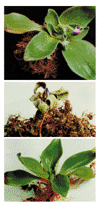What makes desiccation tolerable?
- PMID: 11178232
- PMCID: PMC138847
- DOI: 10.1186/gb-2000-1-2-reviews1010
What makes desiccation tolerable?
Abstract
A comparison of drought tolerance in plants at extreme ends of the evolutionary spectrum is beginning to show the mechanisms involved.
Figures
Similar articles
-
Programmed proteome response for drought avoidance/tolerance in the root of a C(3) xerophyte (wild watermelon) under water deficits.Plant Cell Physiol. 2008 Feb;49(2):226-41. doi: 10.1093/pcp/pcm180. Epub 2008 Jan 4. Plant Cell Physiol. 2008. PMID: 18178965
-
Towards a systems-based understanding of plant desiccation tolerance.Trends Plant Sci. 2009 Feb;14(2):110-7. doi: 10.1016/j.tplants.2008.11.007. Epub 2009 Jan 27. Trends Plant Sci. 2009. PMID: 19179102 Review.
-
Molecular cloning and characterization of wheat calreticulin (CRT) gene involved in drought-stressed responses.J Exp Bot. 2008;59(4):739-51. doi: 10.1093/jxb/erm369. J Exp Bot. 2008. PMID: 18349049
-
A protective role for the polyamine spermine against drought stress in Arabidopsis.Biochem Biophys Res Commun. 2007 Jan 12;352(2):486-90. doi: 10.1016/j.bbrc.2006.11.041. Epub 2006 Nov 16. Biochem Biophys Res Commun. 2007. PMID: 17118338
-
Adaptations of higher plant cell walls to water loss: drought vs desiccation.Physiol Plant. 2008 Oct;134(2):237-45. doi: 10.1111/j.1399-3054.2008.01134.x. Epub 2008 Jun 28. Physiol Plant. 2008. PMID: 18494857 Review.
Cited by
-
Genome-Wide Identification of Cotton (Gossypium spp.) Trehalose-6-Phosphate Phosphatase (TPP) Gene Family Members and the Role of GhTPP22 in the Response to Drought Stress.Plants (Basel). 2022 Apr 15;11(8):1079. doi: 10.3390/plants11081079. Plants (Basel). 2022. PMID: 35448808 Free PMC article.
-
When defense pathways collide. The response of Arabidopsis to a combination of drought and heat stress.Plant Physiol. 2004 Apr;134(4):1683-96. doi: 10.1104/pp.103.033431. Epub 2004 Mar 26. Plant Physiol. 2004. PMID: 15047901 Free PMC article.
-
Mechano-stimulated modifications in the chloroplast antioxidant system and proteome changes are associated with cold response in wheat.BMC Plant Biol. 2015 Sep 11;15:219. doi: 10.1186/s12870-015-0610-6. BMC Plant Biol. 2015. PMID: 26362323 Free PMC article.
-
Expression of heat shock protein-coding genes associated with anhydrobiosis in an African chironomid Polypedilum vanderplanki.Cell Stress Chaperones. 2011 Jan;16(1):81-90. doi: 10.1007/s12192-010-0223-9. Epub 2010 Aug 31. Cell Stress Chaperones. 2011. PMID: 20809134 Free PMC article.
-
Tolerance to oxidative stress induced by desiccation in Porphyra columbina (Bangiales, Rhodophyta).J Exp Bot. 2011 Mar;62(6):1815-29. doi: 10.1093/jxb/erq364. Epub 2010 Dec 31. J Exp Bot. 2011. PMID: 21196477 Free PMC article.
References
-
- Oliver MJ, Tuba Z, Mishler BD. The evolution of desiccation tolerance in land plants. Plant Ecol. 2000.
-
- Lisse T, Bartels D, Kalbitzer HR, Jaenicke R. The recombinant dehydrin-like desiccation stress protein from the resurrection plant Craterostigma plantagineum displays no defined three-dimensional structure in its native state. Biol Chem. 1996;377:555–561. - PubMed
-
- Godoy JA, Lunar R, Torres-Schumann S, Moreno J, Rodrigo RM, Pintor-Toro JA. Expression, tissue distribution and subcellular localization of dehydrin TAS14 in salt-stressed tomato. Plant Mol Biol. 1994;26:1921–1934. - PubMed
-
- Feder ME, Hofmann GE. Heat-shock proteins, molecular chaperones, and the stress response: evolutionary and ecological physiology. Annu Rev Physiol. 1999;61:243–282. - PubMed
Publication types
MeSH terms
Substances
LinkOut - more resources
Full Text Sources


